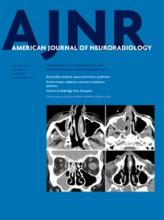Index by author
Desmond, P.M.
- EDITOR'S CHOICEAdult BrainYou have accessImproving Multiple Sclerosis Plaque Detection Using a Semiautomated Assistive ApproachJ. van Heerden, D. Rawlinson, A.M. Zhang, R. Chakravorty, M.A. Tacey, P.M. Desmond and F. GaillardAmerican Journal of Neuroradiology August 2015, 36 (8) 1465-1471; DOI: https://doi.org/10.3174/ajnr.A4375
The authors evaluated and validated a semiautomated software platform to facilitate detection of new lesions and improved MS lesions. Two neuroradiologists retrospectively assessed 161 MR imaging comparison study pairs acquired between 2009 and 2011. More comparison study pairs with new lesions and improved lesions were recorded by using the software compared with original radiology reports.
Dreizin, D.
- Head and Neck ImagingYou have accessHyperintense Optic Nerve due to Diffusion Restriction: Diffusion-Weighted Imaging in Traumatic Optic NeuropathyU.K. Bodanapally, K. Shanmuganathan, R.K. Shin, D. Dreizin, L. Katzman, R.P. Reddy and D. MascarenhasAmerican Journal of Neuroradiology August 2015, 36 (8) 1536-1541; DOI: https://doi.org/10.3174/ajnr.A4290
Duerden, E.G.
- Pediatric NeuroimagingOpen AccessTract-Based Spatial Statistics in Preterm-Born Neonates Predicts Cognitive and Motor Outcomes at 18 MonthsE.G. Duerden, J. Foong, V. Chau, H. Branson, K.J. Poskitt, R.E. Grunau, A. Synnes, J.G. Zwicker and S.P. MillerAmerican Journal of Neuroradiology August 2015, 36 (8) 1565-1571; DOI: https://doi.org/10.3174/ajnr.A4312
Dwyer, M.G.
- Adult BrainOpen AccessLongitudinal Mixed-Effect Model Analysis of the Association between Global and Tissue-Specific Brain Atrophy and Lesion Accumulation in Patients with Clinically Isolated SyndromeM. Varosanec, T. Uher, D. Horakova, J. Hagemeier, N. Bergsland, M. Tyblova, Z. Seidl, M. Vaneckova, J. Krasensky, M.G. Dwyer, E. Havrdova and R. ZivadinovAmerican Journal of Neuroradiology August 2015, 36 (8) 1457-1464; DOI: https://doi.org/10.3174/ajnr.A4330
Ebinger, M.
- EDITOR'S CHOICEAdult BrainOpen AccessHyperintense Vessels on FLAIR: Hemodynamic Correlates and Response to ThrombolysisA. Kufner, I. Galinovic, V. Ambrosi, C.H. Nolte, M. Endres, J.B. Fiebach and M. EbingerAmerican Journal of Neuroradiology August 2015, 36 (8) 1426-1430; DOI: https://doi.org/10.3174/ajnr.A4320
The authors evaluated 62 consecutive patients with ischemic stroke with proven vessel occlusion with MRI before and within 24 hours of treatment and defined a hypoperfusion intensity ratio (volume with severe/mild hypoperfusion [time-to-maximum ≥ 8 seconds / time-to-maximum ≥ 2 seconds]). Patients with extensive hyperintense vessels on FLAIR (>4 sections) had higher NIHSS scores, larger baseline lesion volumes, higher rates of perfusion-diffusion mismatch, and more severe hypoperfusion intensity ratio.
Eikenes, L.
- Adult BrainOpen AccessHow Does the Accuracy of Intracranial Volume Measurements Affect Normalized Brain Volumes? Sample Size Estimates Based on 966 Subjects from the HUNT MRI CohortT.I. Hansen, V. Brezova, L. Eikenes, A. Håberg and T.R. VangbergAmerican Journal of Neuroradiology August 2015, 36 (8) 1450-1456; DOI: https://doi.org/10.3174/ajnr.A4299
Endres, M.
- EDITOR'S CHOICEAdult BrainOpen AccessHyperintense Vessels on FLAIR: Hemodynamic Correlates and Response to ThrombolysisA. Kufner, I. Galinovic, V. Ambrosi, C.H. Nolte, M. Endres, J.B. Fiebach and M. EbingerAmerican Journal of Neuroradiology August 2015, 36 (8) 1426-1430; DOI: https://doi.org/10.3174/ajnr.A4320
The authors evaluated 62 consecutive patients with ischemic stroke with proven vessel occlusion with MRI before and within 24 hours of treatment and defined a hypoperfusion intensity ratio (volume with severe/mild hypoperfusion [time-to-maximum ≥ 8 seconds / time-to-maximum ≥ 2 seconds]). Patients with extensive hyperintense vessels on FLAIR (>4 sections) had higher NIHSS scores, larger baseline lesion volumes, higher rates of perfusion-diffusion mismatch, and more severe hypoperfusion intensity ratio.
Fatterpekar, G.M.
- Adult BrainOpen AccessHigh-Resolution DCE-MRI of the Pituitary Gland Using Radial k-Space Acquisition with Compressed Sensing ReconstructionM.C. Rossi Espagnet, L. Bangiyev, M. Haber, K.T. Block, J. Babb, V. Ruggiero, F. Boada, O. Gonen and G.M. FatterpekarAmerican Journal of Neuroradiology August 2015, 36 (8) 1444-1449; DOI: https://doi.org/10.3174/ajnr.A4324
Fiebach, J.B.
- EDITOR'S CHOICEAdult BrainOpen AccessHyperintense Vessels on FLAIR: Hemodynamic Correlates and Response to ThrombolysisA. Kufner, I. Galinovic, V. Ambrosi, C.H. Nolte, M. Endres, J.B. Fiebach and M. EbingerAmerican Journal of Neuroradiology August 2015, 36 (8) 1426-1430; DOI: https://doi.org/10.3174/ajnr.A4320
The authors evaluated 62 consecutive patients with ischemic stroke with proven vessel occlusion with MRI before and within 24 hours of treatment and defined a hypoperfusion intensity ratio (volume with severe/mild hypoperfusion [time-to-maximum ≥ 8 seconds / time-to-maximum ≥ 2 seconds]). Patients with extensive hyperintense vessels on FLAIR (>4 sections) had higher NIHSS scores, larger baseline lesion volumes, higher rates of perfusion-diffusion mismatch, and more severe hypoperfusion intensity ratio.
Finke, W.
- FELLOWS' JOURNAL CLUBPediatric NeuroimagingYou have accessRadiation Necrosis in Pediatric Patients with Brain Tumors Treated with Proton RadiotherapyS.F. Kralik, C.Y. Ho, W. Finke, J.C. Buchsbaum, C.P. Haskins and C.-S. ShihAmerican Journal of Neuroradiology August 2015, 36 (8) 1572-1578; DOI: https://doi.org/10.3174/ajnr.A4333
The authors performed a retrospective study on 60 consecutive pediatric patients with primary brain tumors treated with proton radiation therapy. Thirty-one percent of patients developed radiation necrosis with a median time to development of 5 months. They conclude that patients with pediatric brain tumors treated with proton radiation therapy demonstrate a high incidence of radiation necrosis and a short time to development of necrosis. Multiple small areas of necrosis are frequently identified on imaging.








